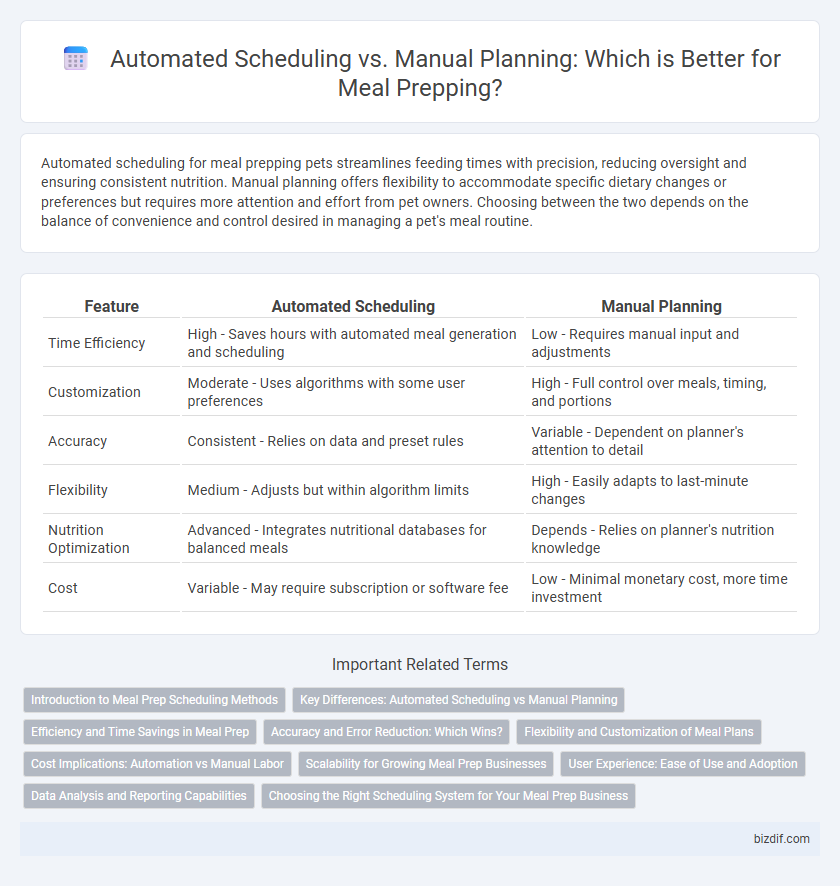Automated scheduling for meal prepping pets streamlines feeding times with precision, reducing oversight and ensuring consistent nutrition. Manual planning offers flexibility to accommodate specific dietary changes or preferences but requires more attention and effort from pet owners. Choosing between the two depends on the balance of convenience and control desired in managing a pet's meal routine.
Table of Comparison
| Feature | Automated Scheduling | Manual Planning |
|---|---|---|
| Time Efficiency | High - Saves hours with automated meal generation and scheduling | Low - Requires manual input and adjustments |
| Customization | Moderate - Uses algorithms with some user preferences | High - Full control over meals, timing, and portions |
| Accuracy | Consistent - Relies on data and preset rules | Variable - Dependent on planner's attention to detail |
| Flexibility | Medium - Adjusts but within algorithm limits | High - Easily adapts to last-minute changes |
| Nutrition Optimization | Advanced - Integrates nutritional databases for balanced meals | Depends - Relies on planner's nutrition knowledge |
| Cost | Variable - May require subscription or software fee | Low - Minimal monetary cost, more time investment |
Introduction to Meal Prep Scheduling Methods
Automated scheduling in meal prepping uses apps and software to streamline ingredient list creation, portion control, and nutritional tracking, ensuring consistent meal plans with minimal effort. Manual planning involves creating meal schedules by hand, offering full customization but requiring more time and attention to detail. Both methods aim to optimize time management and dietary goals, catering to different preferences and lifestyles.
Key Differences: Automated Scheduling vs Manual Planning
Automated scheduling in meal prepping uses algorithms and apps to generate personalized meal plans, optimizing time and nutritional balance based on user preferences and inventory data. Manual planning requires users to select recipes, create shopping lists, and organize meals without digital assistance, allowing for greater flexibility but demanding more time and effort. Key differences include efficiency and accuracy, with automated scheduling reducing planning time and minimizing errors, while manual planning offers more control over customization.
Efficiency and Time Savings in Meal Prep
Automated scheduling in meal prepping significantly enhances efficiency by generating optimized meal plans and grocery lists based on dietary preferences and available ingredients, reducing decision fatigue. Manual planning often consumes considerable time due to repetitive tasks like meal selection and portion calculation, which automation mitigates through smart algorithms. Time savings from automated systems allow users to focus more on cooking and nutrition management, improving overall meal prep productivity.
Accuracy and Error Reduction: Which Wins?
Automated scheduling in meal prepping significantly enhances accuracy by utilizing algorithms that minimize human error in ingredient selection and portion sizes. Manual planning often leads to inconsistencies due to oversight or miscalculations, increasing the risk of nutritional imbalances. Therefore, automated systems provide a reliable solution that reduces errors and ensures precise meal preparation aligned with dietary goals.
Flexibility and Customization of Meal Plans
Automated scheduling in meal prepping offers consistent meal timing but may limit flexibility, as algorithms prioritize standard patterns over individual preferences. Manual planning allows greater customization, enabling users to adapt meals based on dietary changes, ingredient availability, or lifestyle shifts. Prioritizing flexibility and customization in meal plans enhances adherence to nutrition goals and accommodates diverse dietary needs more effectively.
Cost Implications: Automation vs Manual Labor
Automated scheduling in meal prepping reduces labor costs by streamlining inventory management and meal planning through AI-driven algorithms, minimizing human error and time expenditure. Manual planning requires significant time investment from staff, increasing payroll expenses and the likelihood of costly mistakes in ingredient purchasing or portioning. Over time, automation delivers a higher return on investment by optimizing resource allocation and reducing food waste compared to manual labor-intensive methods.
Scalability for Growing Meal Prep Businesses
Automated scheduling systems offer unparalleled scalability for growing meal prep businesses by streamlining order management, inventory tracking, and delivery logistics through AI-driven algorithms. Manual planning often struggles to keep pace with increased order volumes, leading to potential errors and inefficiencies that hinder expansion. Leveraging automated tools enhances operational efficiency, reduces labor costs, and supports seamless growth in competitive meal prep markets.
User Experience: Ease of Use and Adoption
Automated scheduling streamlines meal prepping by instantly generating personalized meal plans based on dietary preferences and calendar availability, reducing user effort and increasing adoption rates. Manual planning demands more time and cognitive load, often leading to inconsistent adherence and user frustration. Enhanced user experience in automated systems fosters higher engagement and long-term commitment to meal prepping routines.
Data Analysis and Reporting Capabilities
Automated scheduling in meal prepping leverages advanced algorithms to analyze historical data, optimize ingredient usage, and generate precise shopping lists, enhancing efficiency and reducing waste. Manual planning relies heavily on personal experience and intuition, often lacking detailed data analysis and comprehensive reporting tools to track nutritional intake or cost metrics. Integrating automated systems provides real-time insights and performance reports, enabling informed adjustments and streamlined meal preparation processes.
Choosing the Right Scheduling System for Your Meal Prep Business
Automated scheduling systems streamline meal prep operations by integrating order management, inventory tracking, and delivery timelines, reducing human error and saving valuable time. Manual planning allows for personalized adjustments and flexibility, beneficial for small-scale or highly customized meal prep businesses. Evaluating business size, complexity, and customer demand helps determine the optimal scheduling system to enhance efficiency and maintain consistency in meal prep workflows.
Automated Scheduling vs Manual Planning Infographic

 bizdif.com
bizdif.com